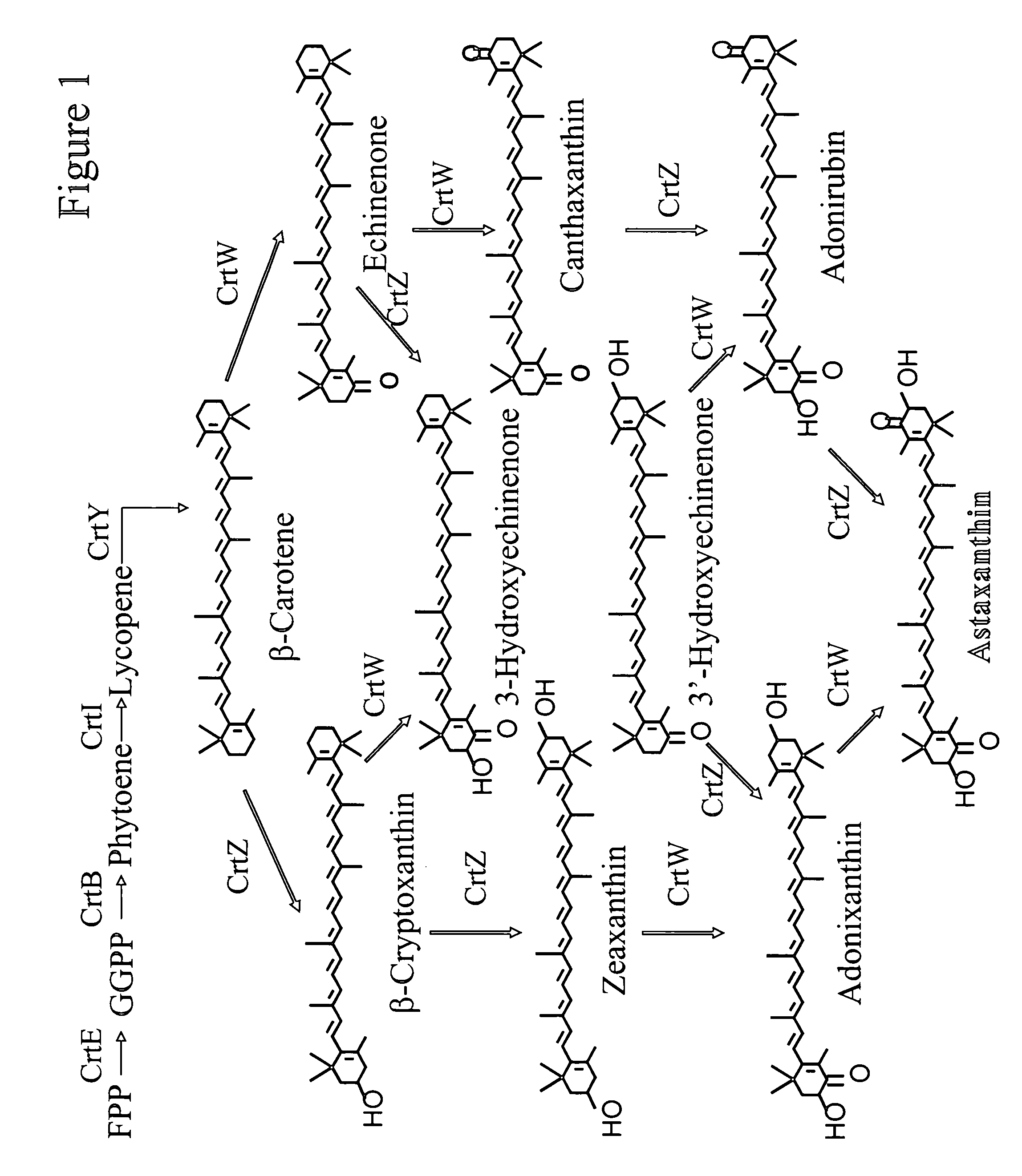Mutant carotenoid ketolase
a technology of carotenoid ketolase and mutated carotenoid, which is applied in the field of biosynthetic pathway engineering and molecular biology to achieve the effect of improving the ability to convert and improving the synthesis activity of astaxanthin
- Summary
- Abstract
- Description
- Claims
- Application Information
AI Technical Summary
Benefits of technology
Problems solved by technology
Method used
Image
Examples
example 1
Construction of the Zeaxanthin Expression System
[0124]Biosynthesis of zeaxanthin in E. coli requires the expression of the crtZ gene and crtEYIB gene cluster. The crtZ gene encodes a carotenoid hydroxylase, while the gene cluster is involved in biosynthesis of β-carotene. To combine these genes into a single cluster, a ligation independent cloning (LIC) method based on α-phosphorothioate (PTO) nucleotide modified primers was used (da Costa, L. and Tanuri, A., J. Virol. Meth., 72:117-121 (1998); Zhou, M. and Hatahet, Z., Nucleic Acids Res., 23(6):1089-1090 (1995); and U.S. Ser. No. 10 / 972,185; herein incorporated by reference). In this procedure, multiple α-thiol linkages are introduced in the primers and used to stop the digestion of the T7 exonuclease at a specific site from 5′ end of the DNA strand, thus generating complementary region for annealing. In the present examples, the α-thiol linkages (PTO modifications) are represented by an “X” within the nucleic acid sequence listed....
example 2
Construction of an Expression System for Low-Level Expression of crtW
[0127]The strategy to design a screening system to identify CrtW variants having higher activity for cyclic hydroxylated carotenoid substrates is based on their colors. When the expression level of the crtW gene on a separate plasmid is low, E. coli cells hosting the zeaxanthin construct pBADcrtZEidiYIB will accumulate large amount of zeaxanthin and adonixanthin. Since both products are yellow, the colonies appear yellowish. If the activity of the CrtW enzyme has been improved after mutagenesis, more of the zeaxanthin and adonixanthin will be converted to astaxanthin in the cell. Since the astaxanthin has an orange color, the colonies will appear orange.
[0128]To express a low level of the crtW gene, the low copy number plasmid pSU18 was used (Martinez et al., Gene, 68:159-162 (1998)). The pSU18 vector was amplified with primer sets PSUB180F-1 (fos1) (5′-taacgatgcaaaacgcatcctgccaXcXcXaXtcatacactaaatcagtaag-3′; SEQ I...
example 3
Mutagenesis of the crtW gene and Screening of Positive Clones
[0130]The in vitro mutagenesis of crtW gene was carried out with the error-prone PCR kit (GeneMorph® II Random Mutagenesis kit, Stratagene, La Jolla, Calif.). The first library was constructed with the template DNA generated by amplifying the crtW gene (SEQ ID NO: 1) with primer set CrtW334 F (EcoR1) (SEQ ID NO: 19) and CrtW334-R(SacIMfe) (SEQ ID NO: 20) with a high fidelity enzyme Pfx (Invitrogen). The amount of template used for error-prone PCR was 100 ng and 25 rounds of amplification was carried out in order to achieve 0-4 mutations per kilobase (kb) of sequence. The second library used the error-prone PCR product from the first library as template. The PCR products were gel purified and digested with EcoRI and SacI. The cloning vector was prepared by digesting the pSU18crtW construct with EcoR1 and SacI. After ligation, the reaction mixture was transformed into E. coli TOP10 cells harboring the pBADcrtZEidiYIB plasmid...
PUM
| Property | Measurement | Unit |
|---|---|---|
| pH | aaaaa | aaaaa |
| temperature | aaaaa | aaaaa |
| wavelength range | aaaaa | aaaaa |
Abstract
Description
Claims
Application Information
 Login to View More
Login to View More - R&D
- Intellectual Property
- Life Sciences
- Materials
- Tech Scout
- Unparalleled Data Quality
- Higher Quality Content
- 60% Fewer Hallucinations
Browse by: Latest US Patents, China's latest patents, Technical Efficacy Thesaurus, Application Domain, Technology Topic, Popular Technical Reports.
© 2025 PatSnap. All rights reserved.Legal|Privacy policy|Modern Slavery Act Transparency Statement|Sitemap|About US| Contact US: help@patsnap.com



